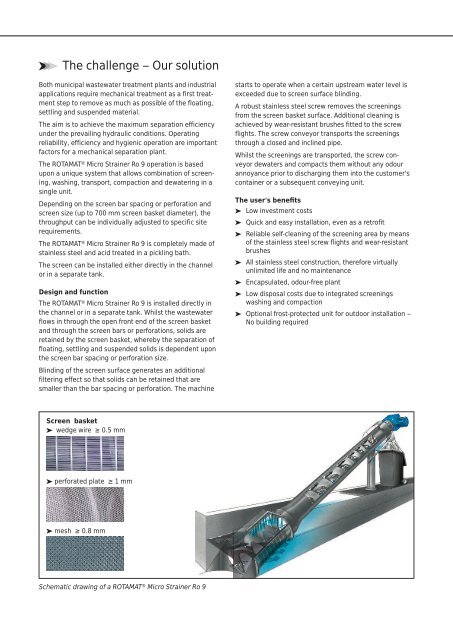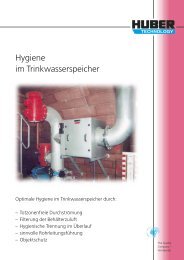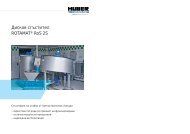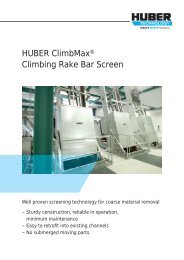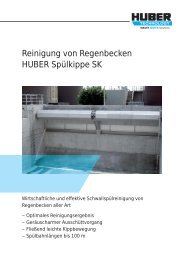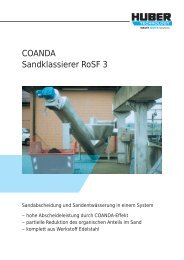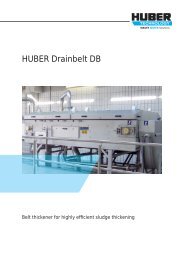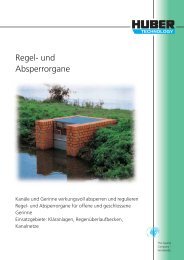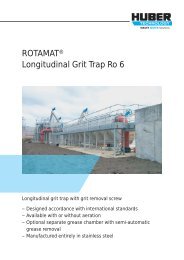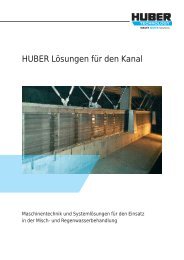ROTAMAT® Micro Strainer Ro 9
ROTAMAT® Micro Strainer Ro 9
ROTAMAT® Micro Strainer Ro 9
Create successful ePaper yourself
Turn your PDF publications into a flip-book with our unique Google optimized e-Paper software.
➤ The challenge – Our solution<br />
Both municipal wastewater treatment plants and industrial<br />
applications require mechanical treatment as a first treatment<br />
step to remove as much as possible of the floating,<br />
settling and suspended material.<br />
The aim is to achieve the maximum separation efficiency<br />
under the prevailing hydraulic conditions. Operating<br />
reliability, efficiency and hygienic operation are important<br />
factors for a mechanical separation plant.<br />
The <strong>ROTAMAT®</strong> <strong>Micro</strong> <strong>Strainer</strong> <strong>Ro</strong> 9 operation is based<br />
upon a unique system that allows combination of screening,<br />
washing, transport, compaction and dewatering in a<br />
single unit.<br />
Depending on the screen bar spacing or perforation and<br />
screen size (up to 700 mm screen basket diameter), the<br />
throughput can be individually adjusted to specific site<br />
requirements.<br />
The <strong>ROTAMAT®</strong> <strong>Micro</strong> <strong>Strainer</strong> <strong>Ro</strong> 9 is completely made of<br />
stainless steel and acid treated in a pickling bath.<br />
The screen can be installed either directly in the channel<br />
or in a separate tank.<br />
Design and function<br />
The <strong>ROTAMAT®</strong> <strong>Micro</strong> <strong>Strainer</strong> <strong>Ro</strong> 9 is installed directly in<br />
the channel or in a separate tank. Whilst the wastewater<br />
flows in through the open front end of the screen basket<br />
and through the screen bars or perforations, solids are<br />
retained by the screen basket, whereby the separation of<br />
floating, settling and suspended solids is dependent upon<br />
the screen bar spacing or perforation size.<br />
Blinding of the screen surface generates an additional<br />
filtering effect so that solids can be retained that are<br />
smaller than the bar spacing or perforation. The machine<br />
starts to operate when a certain upstream water level is<br />
exceeded due to screen surface blinding.<br />
A robust stainless steel screw removes the screenings<br />
from the screen basket surface. Additional cleaning is<br />
achieved by wear-resistant brushes fitted to the screw<br />
flights. The screw conveyor transports the screenings<br />
through a closed and inclined pipe.<br />
Whilst the screenings are transported, the screw conveyor<br />
dewaters and compacts them without any odour<br />
annoyance prior to discharging them into the customer's<br />
container or a subsequent conveying unit.<br />
The user's benefits<br />
➤ Low investment costs<br />
➤ Quick and easy installation, even as a retrofit<br />
➤ Reliable self-cleaning of the screening area by means<br />
of the stainless steel screw flights and wear-resistant<br />
brushes<br />
➤ All stainless steel construction, therefore virtually<br />
unlimited life and no maintenance<br />
➤ Encapsulated, odour-free plant<br />
➤ Low disposal costs due to integrated screenings<br />
washing and compaction<br />
➤ Optional frost-protected unit for outdoor installation –<br />
No building required<br />
Screen basket<br />
➤ wedge wire ≥ 0.5 mm<br />
➤ perforated plate ≥ 1 mm<br />
➤ mesh ≥ 0.8 mm<br />
Schematic drawing of a <strong>ROTAMAT®</strong> <strong>Micro</strong> <strong>Strainer</strong> <strong>Ro</strong> 9


